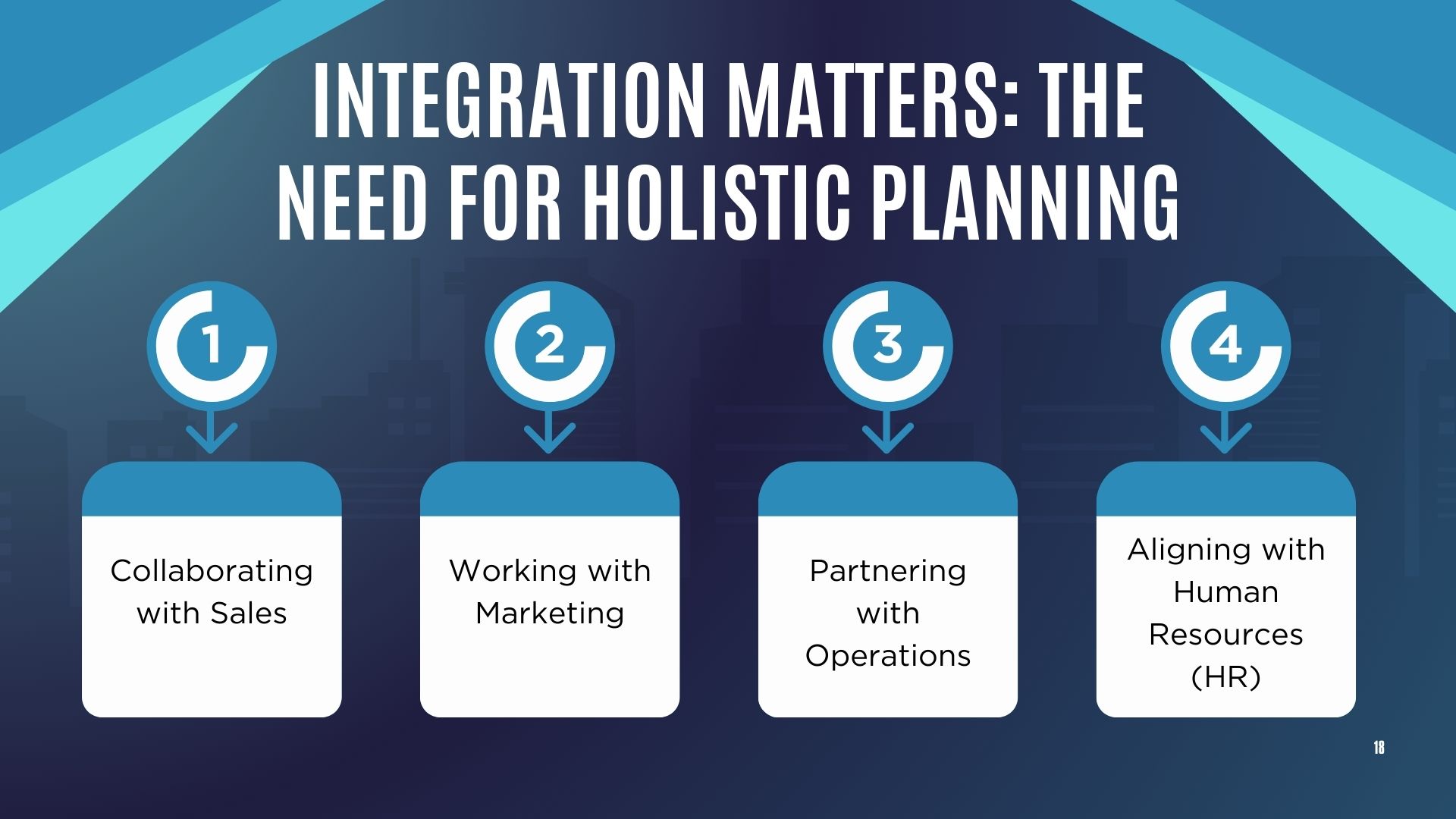Integrating FP&A with Other Business Functions for Better Decision-Making
In today’s complex business environment, Financial Planning and Analysis (FP&A) is no longer confined to the finance department alone. To drive truly effective financial planning, FP&A teams must work closely with other key business functions, including sales, marketing, operations, and human resources (HR). This cross-functional collaboration leads to more accurate forecasts, better alignment with business goals, and improved decision-making.
In this article, we’ll explore why integrating FP&A with other business functions is crucial and how stronger collaboration can help organizations achieve better financial outcomes.
Why Integration Matters: The Need for Holistic Planning
In traditional business models, departments such as finance, sales, marketing, operations, and HR often work in silos. Each department focuses on its own objectives, which can sometimes lead to disjointed planning processes. FP&A teams, which typically rely on historical data and financial indicators to guide decision-making, may struggle to fully understand or anticipate the real-world operational and strategic challenges faced by other departments.
By integrating FP&A with other functions, organizations can:
- Improve Forecast Accuracy: When FP&A teams have insights from sales, marketing, operations, and HR, they can develop forecasts that are more aligned with reality and take into account variables beyond financial data alone.
- Align Business Goals: A cohesive approach ensures that all departments are working toward the same objectives, allowing for more streamlined decision-making and better execution of business strategies.
- Drive Agility: In today’s fast-changing business environment, it’s crucial to make real-time adjustments. Collaboration between FP&A and other functions ensures that business leaders can respond to market changes quickly and effectively.
Let’s dive deeper into how integrating FP&A with specific business functions can enhance decision-making.

1. Collaborating with Sales
Key Areas of Collaboration:
- Revenue Forecasting: Sales teams have intimate knowledge of customer trends, buying cycles, and market demands. By working closely with the FP&A team, they can provide insights into pipeline health, expected sales volumes, and seasonality. This enables FP&A to create more accurate revenue forecasts.
- Sales Targets and Budgeting: FP&A teams can help sales departments align their goals with the organization’s overall financial objectives. Through collaboration, sales targets can be set based on realistic financial expectations, and resources can be allocated more efficiently.
- Scenario Planning: Sales teams are often aware of emerging market conditions or competitor actions. Sharing this information with FP&A allows for more informed scenario planning, where financial outcomes can be adjusted based on different sales outcomes or changing market dynamics.
Why It Matters:
Accurate revenue forecasting is the backbone of any financial plan. When FP&A has a close working relationship with sales, it can incorporate market realities into financial forecasts, minimizing surprises and improving cash flow management. Furthermore, sales performance data can drive better budgeting decisions, ensuring the business is equipped to meet targets.
2. Working with Marketing
Key Areas of Collaboration:
- Marketing Campaign ROI: Marketing teams can provide FP&A with data on the expected return on investment (ROI) for various marketing campaigns. This helps FP&A assess the potential impact of marketing efforts on revenue and adjust financial forecasts accordingly.
- Customer Acquisition and Retention Costs: Marketing has valuable insights into customer acquisition costs, retention strategies, and customer lifetime value (CLTV). By sharing this information with FP&A, it’s possible to assess whether customer acquisition strategies are sustainable and whether future revenue can support growth plans.
- Budget Allocation: Marketing teams often operate with limited budgets. By collaborating with FP&A, they can ensure that resources are allocated optimally, based on expected returns and aligned with overall financial goals.
Why It Matters:
Marketing is crucial in driving revenue growth, and having access to their data helps FP&A create accurate projections. Collaborating with marketing also enables FP&A to assess the efficiency of marketing spend and adjust future budgets to maximize ROI.
3. Partnering with Operations
Key Areas of Collaboration:
- Cost Structure and Efficiency: Operations teams are responsible for managing production, supply chain, and overall cost structure. By working with FP&A, operations can provide insights into cost trends, capacity utilization, and resource requirements, allowing FP&A to adjust financial plans accordingly.
- Inventory Management: FP&A teams need accurate data on inventory levels to project cash flow needs and plan for working capital. Operations can provide insights into inventory turnover rates and potential supply chain disruptions, helping FP&A create more accurate financial projections.
- Capital Expenditure (CapEx) Planning: FP&A and operations teams need to collaborate closely when it comes to major capital investments, such as purchasing new equipment or expanding facilities. Understanding the potential ROI of such investments helps ensure that capital expenditures align with broader financial goals.
Why It Matters:
Operations teams hold the key to understanding cost dynamics and efficiency improvements. Integrating this knowledge with FP&A helps to optimize cost structures, improve profitability, and manage working capital more effectively.
4. Aligning with Human Resources (HR)
Key Areas of Collaboration:
- Workforce Planning: HR has a direct impact on labor costs, headcount planning, and employee retention. By collaborating with FP&A, HR can provide insights into salary trends, hiring plans, and potential changes in labor costs, which are critical components of financial forecasting.
- Compensation and Benefits Costs: HR teams are also responsible for managing compensation and benefits programs. FP&A teams can work with HR to project the financial impact of these programs, ensuring that the business is prepared for both current and future costs.
- Talent Acquisition and Retention: Skilled employees are often the most significant asset a company has. HR can help FP&A understand the impact of hiring, retention, and training efforts on the company’s financial health, helping to balance workforce needs with budget constraints.
Why It Matters:
Labor costs often represent a substantial portion of a company’s total expenses. Aligning FP&A with HR helps organizations accurately predict labor expenses and plan for hiring needs in a way that aligns with financial goals.
Benefits of Cross-Functional Collaboration
- More Accurate Financial Planning: By integrating data from sales, marketing, operations, and HR, FP&A teams can develop more precise financial forecasts, taking into account all relevant factors. This results in more accurate budgeting, forecasting, and financial projections.
- Better Strategic Decision-Making: Cross-functional collaboration ensures that decisions are based on a holistic view of the business. When all departments are involved in financial planning, it leads to more informed, data-driven decisions that align with overall business goals.
- Improved Agility and Responsiveness: In a rapidly changing business environment, organizations need to be able to adjust their plans quickly. Cross-functional collaboration ensures that all departments are on the same page and can respond to changes in the market or internal operations with agility.

Overcoming Barriers to Collaboration
Despite the clear benefits, cross-functional collaboration doesn’t always come easily. Here are a few ways FP&A teams can overcome potential challenges:
- Foster Open Communication: Encouraging open lines of communication across departments is essential. Regular meetings, joint planning sessions, and transparent data sharing can help break down silos and encourage collaboration.
- Leverage Technology: Integrated software platforms and cloud-based financial planning tools can facilitate data sharing between departments. These tools allow for real-time updates, better visibility, and collaborative decision-making.
- Establish Clear Goals and Expectations: Aligning business functions around common objectives ensures that all teams are working toward the same financial and operational goals. Clear communication about the role each department plays in the financial planning process is key.
Conclusion: Achieving Better Decision-Making Through Integration
Integrating FP&A with sales, marketing, operations, and HR is no longer a luxury — it’s a necessity for modern businesses that seek to make better, more informed decisions. By collaborating across departments, FP&A teams can develop more accurate forecasts, align business objectives, and respond more effectively to changes in the market or internal operations.
Ultimately, integration leads to a more holistic approach to financial planning, where decisions are based on a comprehensive understanding of all business functions. When each department is aligned and working together, businesses can navigate challenges more effectively, seize opportunities with confidence, and ultimately achieve greater success.
